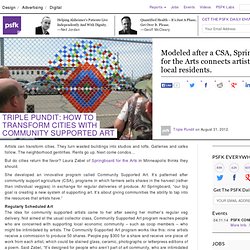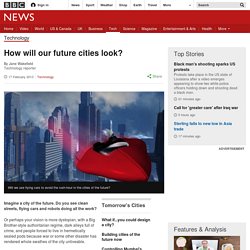

Serenbe. Triple Pundit: How To Transform Cities With Community Supported Art. Artists can transform cities.

They turn wasted buildings into studios and lofts. Galleries and cafes follow. The neighborhood gentrifies. Rents go up. Next come condos… But do cities return the favor? She developed an innovative program called Community Supported Art. Regularly Scheduled Art The idea for community supported artists came to her after seeing her mother’s regular veg delivery. The Community Supported Art program in Minneapolis is so popular, it regularly sells out.
Image credit: Scott Streble (Continue reading original article here.) How will our future cities look? Imagine a city of the future.

Do you see clean streets, flying cars and robots doing all the work? Or perhaps your vision is more dystopian, with a Big Brother-style authoritarian regime, dark alleys full of crime, and people forced to live in hermetically sealed pods because war or some other disaster has rendered whole swathes of the city unliveable. No-one really knows what the future holds, but the reality now is that our urban spaces are overcrowded and polluted. Almost half of the world's population currently lives in cities, and by 2050 that is projected to increase to 75%, but what kind of city will they be living in? The time is ripe, say experts, to start designing smarter urban environments, both new cities needed to sustain an ever-growing population, and retro-fits on the ones that we have lived in for centuries.
Greenification Some of these revolve around the idea that smarter equals greener. Behind such greenification of cities lies a very pressing need. Nerve centre. Redesigning A Less Wasteful New York City, With Giant Trash-Composting Parks. Much of New York City was built on top of trash generated by 17th century Dutchmen.

But modern-day inhabitants have drifted further and further from the city’s utilitarian roots. Instead of recycling or composting, New York City now spends hundreds of millions of dollars to truck garbage to dumps (called “transfer stations”), which then truck or float that garbage to landfills located as far away as Texas. It’s less reckoning with a problem and more shoving the byproducts of urban living out of sight. Dealing with the massive amount of trash the city produces on-site is a monumental and ongoing task. But two local architects decided to leap several years into the future, in which they imagine New York City as a composting utopia. Inspired by city pilot programs that have started asking residents to compost, Erlebacher and Guimond wondered what it might take to beautify a traditional compost heap.
London Joins The List Of Cities Trying To Build Swimming Pools In Their Rivers. When it comes to inventive urbanism, big cities tend to copy one another.

Bike sharing, riverside beaches, and High Line-type initiatives--they were all good ideas that started in one location before being widely imitated. The latest trend: swimming pools carved out of rivers. New York has a project, called +Pool, which has raised more than $300,000 in crowd-funding, and looks set for a 2016 launch. Now London wants in. A consortium is proposing the Thames Baths Project, a freshwater lagoon amid the meandering old waterway. The renderings here are from Studio Octopi, Civic Engineers and Jonathan Cook Landscape Architects, which won a competition last year to come up with new river uses.
In Portland, These Tiny Houses Will Bring The Homeless Off The Street And Under A Roof. Earlier this year, Portland's decade-long plan to end homelessness expired without reaching its goal.

A local entrepreneur, frustrated with the lack of action, decided to do something himself. What Is the Lab? IDEAS CITY. The City Resilient. Join a remarkable network of innovators for a one-of-a-kind summit on building resilient communities W e live in a time of increasing volatility. Disruptions of all kinds – from the economic to the ecological, from the social to the geopolitical – arrive with little warning, from surprising directions, and leave serious consequences in their wake. Amid this volatility, cities serve as both the epicenters of vulnerability, and the crucibles of resilience.
And this raises a host of important questions: How do we empower communities to improve their self-reliance and act effectively on their own behalf? How do we build new social networks and social capital that cuts across socioeconomic lines? Introducing The City Resilient. Maker Cities. There is a great deal of momentum behind the Maker Movement.

I have previously written about making in schools and in libraries. One thing is clear, people enjoy making stuff like 3D printer bunny rabbits or mobile apps for disaster preparedness, but there isn't necessarily a shared vision for where this movement is headed, or what potential it may hold. As humanity finds itself facing environmental disaster, resource scarcity, political and economic struggle, and various other challenges, a more focused Maker Movement would have the power to address these challenges and innovate on what it means to be human. Perhaps this group of people who are trying to make the world around them better, perhaps they can make the entire world better while they're at it. Learn, Launch and Find a Job in NYC Tech.